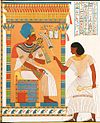Treasurer (Ancient Egypt)
| Treasurer in hieroglyphs | ||||
|---|---|---|---|---|
imi-r ḫtmt Overseer of the Seal / Overseer of sealed things | ||||
The Treasurer (or often also translated as Chancellor) in Ancient Egypt is the modern translation of the title imi-r ḫtmt (word by word: Overseer of the Seal or Overseer of sealed things). The office is known since the end of the Old Kingdom, where people with this title appear sporadically in the organization of private estates.
In the Middle Kingdom, the office became one of the most important ones at the royal court. At the end of the 18th Dynasty, the title lost its importance, although the famous Bay had this office. In the later New Kingdom the function of a treasurer was overtaken by the overseer of the treasury.
The treasurer was responsible for products coming to the royal palace. They were the main economic administrator of the royal belongings.
Middle Kingdom title holders
- Bebi, was later appointed vizier, under Mentuhotep II
- Kheti, under Mentuhotep II
- Meketre, under Mentuhotep II and after
- Ipi, under Amenemhet I
- Rehuerdjersen, under Amenemhet I or later
- Sobekhotep, under Senusret I, year 22
- Mentuhotep, under Senusret I
- Merykau, under Amenemhat II
- Siese, was later appointed vizier, under Amenemhat II
- Senankh, under Senusret III
- Sobekemhat under Senusret III
- Iykhernofret, under Senusret III
- Senusretankh, under Amenemhat III[1]
- Senebsumai, Thirteenth Dynasty
- Senebi, Thirteenth Dynasty
- Amenhotep, Thirteenth Dynasty
New Kingdom title holders
- Neferperet, under Ahmose I
- Ahmose Pen-Nekhebet, under Ahmose I to Hatshepsut
- Nehsi, under Hatshepsut
- Tay, under Hatshepsut
- Sennefer, under Thutmose III
- Min, under Thutmose III
- Sobekhotep, under Thutmose IV
- Meryre, under Amenhotep III
- Ptahmose, under Amenhotep III, after year 30
- Bay, under Seti II
Late Period
- Udjahorresnet, under Cambyses II and Darius I
References
- ^ Kei Yamamotoː Treasurer Senwosretankh, favored of Amenemhat III. In Christina Geisen, Jean Li, Steven Shubert, and Kei Yamamoto (eds)ː His good name: essays on identity and self-presentation in ancient Egypt in honor of Ronald J. Leprohon, Atlanta, GA: Lockwood Press 2021, 249-255.
Literature
- Stephen Quirke: Titles and bureaux of Egypt 1850-1700 BC, London 2004 p. 48-49 ISBN 0-9547218-0-2

